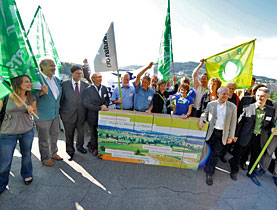
Voters to be given chance to halt urban sprawl

A coalition led by environmental organisations is seeking to place a 20-year moratorium on further urban development in Switzerland.
The environmental groups, spatial planning experts and parliamentarians submitted more than 110,000 signatures on Thursday to force a nationwide vote on the issue.
The 16 different groups included the Swiss chapter of Friends of the Earth and WWF.
“There is widespread support in the population for our fight to protect our environment, which we saw during the signature-collecting campaign,” said Otto Sieber of Friends of the Earth/Pro Natura at a news conference.
Sieber added that the groups decided to hand in the signatures, gathered over just 13 months, before the cabinet presents a draft for an overhaul of the federal zoning law later this year.
The government is also facing calls from international experts to ensure a more coherent land use policy.
Sieber claims another 50,000 signatures could easily have been collected in the remaining statutory five months.
Simonetta Sommaruga, a senator for the centre-left Social Democrats, stressed the urgency of the planned moratorium.
To Paris
She pointed out that 30km2 of land has been developed since the launch of the initiative.
“It’s the equivalent of 4,200 football parks. Together they would form a line from Bern to Paris,” she said.
Sommaruga added that the present laws are inefficient, because they would not put an end to what environmentalists consider a waste of natural resources.
“More than a quarter of the designated territory for building purposes is not developed. But nevertheless more land is put aside by the communes.”
The supporters of a moratorium on urban development, including the Green Party, the Social Democrats and the centre-right Christian Democrats, dismiss allegations that their proposal will block any further growth.
Under current regulations, local authorities and cantons can swap land with other communes due to their widespread autonomy.
Raimund Rodewald of the Foundation for Landscape Protection of is convinced that the proposed system can work.
“It is similar to a regulation on the use of forests in Switzerland. Clearings are only allowed if the same surface is re-forested elsewhere.”

More
People’s initiative
Cooperation
The coalition called on the authorities to improve cooperation within Switzerland’s federalist system.
“At present the communes are in competition with each other and give financial incentives to attract investors. This is detrimental to the environment,” said Sommaruga.
However, there appears to be scope for better cooperation among the environmental organisations.
Last December, a prominent environmentalist, Franz Weber, handed in an initiative with similar goals, but which demands an outright ban on major industrial compounds, shopping malls outside cities and huge car parks.
His proposal came in response to a project by the United States biotech company, Amgen, to construct a production plant at a green-field site in western Switzerland.
Rodewald told swissinfo that Weber’s group had decided to go it alone.
“It is not necessarily bad to have two initiatives on the same subject. It allows us to apply more pressure,” he said.
swissinfo, Urs Geiser
The groups collected about 110,000 signatures to force a nationwide vote for a urban development moratorium.
Parliament and cabinet still have to discuss the issue before a date for the vote is set.
The House Owners Assocation has come out against the initiative saying it would result in an increase in property prices.
A similar initiative by environmentalist Franz Weber was handed in last December.
The government is due to publish a first draft of proposals for an overhaul of the federal zoning law later this year.
Switzerland’s 26 cantons and more than 2,700 local authorities are largely autonomous in building and planning matters.
According to the Federal Spatial Development Office, three-quarters of the population resides in Switzerland’s agglomerations, which extend from the core towns and cities far out into the countryside.
It said in its 2005 report that these agglomerations were marked by “sparsely populated regions featuring extensive estates of detached housing, unstructured industrial and business zones, shopping centres and leisure areas with enormous car parks”.
The Spatial Development Office added that the land taken up by these agglomerations “has been growing faster than the total population” with the “countryside losing its rural character without having gained urban qualities”.
The environmental organisation Pro Natura Switzerland claims that every second, a square metre of land disappears under concrete and asphalt.

In compliance with the JTI standards
More: SWI swissinfo.ch certified by the Journalism Trust Initiative




























You can find an overview of ongoing debates with our journalists here . Please join us!
If you want to start a conversation about a topic raised in this article or want to report factual errors, email us at english@swissinfo.ch.